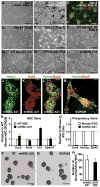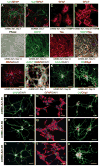Direct reprogramming of mouse and human fibroblasts into multipotent neural stem cells with a single factor
- PMID: 22683203
- PMCID: PMC3399516
- DOI: 10.1016/j.stem.2012.05.018
Direct reprogramming of mouse and human fibroblasts into multipotent neural stem cells with a single factor
Abstract
The generation of induced pluripotent stem cells (iPSCs) and induced neuronal cells (iNCs) from somatic cells provides new avenues for basic research and potential transplantation therapies for neurological diseases. However, clinical applications must consider the risk of tumor formation by iPSCs and the inability of iNCs to self-renew in culture. Here we report the generation of induced neural stem cells (iNSCs) from mouse and human fibroblasts by direct reprogramming with a single factor, Sox2. iNSCs express NSC markers and resemble wild-type NSCs in their morphology, self-renewal, ability to form neurospheres, and gene expression profiles. Cloned iNSCs differentiate into several types of mature neurons, as well as astrocytes and oligodendrocytes, indicating multipotency. Implanted iNSCs can survive and integrate in mouse brains and, unlike iPSC-derived NSCs, do not generate tumors. Thus, self-renewable and multipotent iNSCs without tumorigenic potential can be generated directly from fibroblasts by reprogramming.
Copyright © 2012 Elsevier Inc. All rights reserved.
Figures




Similar articles
-
Direct reprogramming of Sertoli cells into multipotent neural stem cells by defined factors.Cell Res. 2012 Jan;22(1):208-18. doi: 10.1038/cr.2011.175. Epub 2011 Nov 8. Cell Res. 2012. PMID: 22064700 Free PMC article.
-
A combination of small molecules directly reprograms mouse fibroblasts into neural stem cells.Biochem Biophys Res Commun. 2016 Jul 15;476(1):42-8. doi: 10.1016/j.bbrc.2016.05.080. Epub 2016 May 17. Biochem Biophys Res Commun. 2016. PMID: 27207831
-
Sonic Hedgehog Effectively Improves Oct4-Mediated Reprogramming of Astrocytes into Neural Stem Cells.Mol Ther. 2019 Aug 7;27(8):1467-1482. doi: 10.1016/j.ymthe.2019.05.006. Epub 2019 May 16. Mol Ther. 2019. PMID: 31153826 Free PMC article.
-
Take the shortcut - direct conversion of somatic cells into induced neural stem cells and their biomedical applications.FEBS Lett. 2019 Dec;593(23):3353-3369. doi: 10.1002/1873-3468.13656. Epub 2019 Dec 1. FEBS Lett. 2019. PMID: 31663609 Free PMC article. Review.
-
Concise review: the involvement of SOX2 in direct reprogramming of induced neural stem/precursor cells.Stem Cells Transl Med. 2013 Aug;2(8):579-83. doi: 10.5966/sctm.2012-0179. Epub 2013 Jul 1. Stem Cells Transl Med. 2013. PMID: 23817132 Free PMC article. Review.
Cited by
-
Probing disorders of the nervous system using reprogramming approaches.EMBO J. 2015 Jun 3;34(11):1456-77. doi: 10.15252/embj.201591267. Epub 2015 Apr 29. EMBO J. 2015. PMID: 25925386 Free PMC article. Review.
-
Transplantation of human induced cerebellar granular-like cells improves motor functions in a novel mouse model of cerebellar ataxia.Am J Transl Res. 2016 Feb 15;8(2):705-18. eCollection 2016. Am J Transl Res. 2016. PMID: 27158363 Free PMC article.
-
Regeneration through reprogramming adult cell identity in vivo.Am J Pathol. 2015 Oct;185(10):2619-28. doi: 10.1016/j.ajpath.2015.02.025. Epub 2015 Jun 6. Am J Pathol. 2015. PMID: 26056931 Free PMC article. Review.
-
Cellular Reprogramming Using Defined Factors and MicroRNAs.Stem Cells Int. 2016;2016:7530942. doi: 10.1155/2016/7530942. Epub 2016 Jun 12. Stem Cells Int. 2016. PMID: 27382371 Free PMC article. Review.
-
Induction of Neural Progenitor-Like Cells from Human Fibroblasts via a Genetic Material-Free Approach.PLoS One. 2015 Aug 12;10(8):e0135479. doi: 10.1371/journal.pone.0135479. eCollection 2015. PLoS One. 2015. PMID: 26266943 Free PMC article.
References
-
- Bylund M, Andersson E, Novitch BG, Muhr J. Vertebrate neurogenesis is counteracted by Sox1–3 activity. Nat Neurosci. 2003;6:1162–1168. - PubMed
-
- Caiazzo M, Dell’Anno MT, Dvoretskova E, Lazarevic D, Taverna S, Leo D, Sotnikova TD, Menegon A, Roncaglia P, Colciago G, et al. Direct generation of functional dopaminergic neurons from mouse and human fibroblasts. Nature. 2011;476:224–227. - PubMed
-
- Dimos JT, Rodolfa KT, Niakan KK, Weisenthal LM, Mitsumoto H, Chung W, Croft GF, Saphier G, Leibel R, Goland R, et al. Induced pluripotent stem cells generated from patients with ALS can be differentiated into motor neurons. Science. 2008;321:1218–1221. - PubMed
Publication types
MeSH terms
Substances
Grants and funding
LinkOut - more resources
Full Text Sources
Other Literature Sources
Molecular Biology Databases

